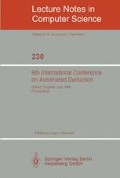Abstract
Dynamic logic QDL as presented in |3| provides a comprehensive logical framework for the study of the before-after behaviour of deterministic and non-deterministic programs. While the set of all valid QDL-formulas is highly complex (π 11 -complete) and hence not axiomatizable, the subset of valid termination assertions was shown to be axiomatizable in |5|. In |8|, this result was generalized to the effect that the much larger QDL-fragment of diamond formulas is still axiomatizable and satisfies a compactness theorem. The proofs were based on a rather delicate proof-theoretical treatment of consistency properties. We show how results of this kind can be obtained in the general framework of recursively enumerable dynamic logic by a very flexible approach that uses only the compactness and completeness of first-order logic and saturated structures. The method is also applicable to the dynamic logic involving undeclared global procedures and recursive procedure calls studied in |6|.
Preview
Unable to display preview. Download preview PDF.
References
1 J. Barwise, J. Schlipf, An introduction to recursively saturated and resplendent models, J.Symb.Logic 41 (1976), 531–536.
2 D.Harel, First-order dynamic logic, Springer LNCS vol.68, 1979.
3 —"—, Dynamic logic, in The Handbook of Philosophical Logic, vol.II, Reidel, Dordrecht, 1984.
4 A.R. Meyer, R. Parikh, Definability in dynamic logic, J.Comp.Syst.Sci. 23 (1981), 279–298.
5 A.R. Meyer, J.Y. Halpern, Axiomatic definitions of programming languages: A theoretical assessment, J. ACM 29 (1982), 555–576.
6 A.R. Meyer, J.C. Mitchell, Termination assertions for recursive programs: Completeness and axiomatic definability, Inf. & Control 56 (1983), 112–138.
7 G. Sacks, Saturated Model Theory, Benjamin, Reading, Mass., 1972.
8 P.H. Schmitt, Diamond formulas: A fragment of dynamic logic with recursively enumerable validity problem, Inf. & Control 61 (1984), 147–158.
9 V. Weispfenning, Infinitary model theoretic properties of κ-saturated structures, Z. math. Logik u. G. M., 19 (1973), 97–109.
Author information
Authors and Affiliations
Editor information
Rights and permissions
Copyright information
© 1986 Springer-Verlag Berlin Heidelberg
About this paper
Cite this paper
Weispfenning, V. (1986). Diamond formulas in the dynamic logic of recursively enumerable programs. In: Siekmann, J.H. (eds) 8th International Conference on Automated Deduction. CADE 1986. Lecture Notes in Computer Science, vol 230. Springer, Berlin, Heidelberg. https://doi.org/10.1007/3-540-16780-3_120
Download citation
DOI: https://doi.org/10.1007/3-540-16780-3_120
Published:
Publisher Name: Springer, Berlin, Heidelberg
Print ISBN: 978-3-540-16780-8
Online ISBN: 978-3-540-39861-5
eBook Packages: Springer Book Archive

